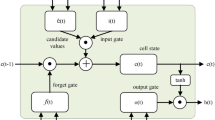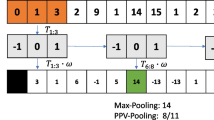Abstract
The development of power system informatization, the massive access of distributed power supply and electric vehicles have increased the complexity of power consumption in the distribution network, which puts forward higher requirements for the accuracy and stability of load forecasting. In this paper, an integrated network architecture which consists of the self-organized mapping, chaotic time series, intelligent optimization algorithm and long short-term memory (LSTM) is proposed to extend the load forecasting length, decrease artificial debugging, and improve the prediction precision for the short-term power load forecasting. Compared with LSTM prediction, the algorithm in this paper improves the prediction accuracy by 61.87% in terms of root mean square error (RMSE), and reduces the prediction error by 50% in the 40-fold forecast window under some circumstances.
Similar content being viewed by others
References
Amjady N. Short-term hourly load forecasting using time-series modeling with peak load estimation capability. IEEE Trans Power Syst, 2001, 16: 798–805
Fan G F, Peng L L, Hong W C, et al. Electric load forecasting by the SVR model with differential empirical mode decomposition and auto regression. Neurocomputing, 2016, 173: 958–970
Hu R, Wen S, Zeng Z, et al. A short-term power load forecasting model based on the generalized regression neural network with decreasing step fruit fly optimization algorithm. Neurocomputing, 2017, 221: 24–31
Ryu S, Noh J, Kim H. Deep neural network based demand side short term load forecasting. In: Proceedings of the 2016 IEEE International Conference on Smart Grid Communications. IEEE, 2016. 10: 308
Dedinec A, Filiposka S, Dedinec A, et al. Deep belief network based electricity load forecasting: An analysis of Macedonian case. Energy, 2016, 115: 1688–1700
Cherif A, Cardot H, Bone R. SOM time series clustering and prediction with recurrent neural networks. Neurocomputing, 2011, 74: 1936–1944
Dong X, Qian L, Huang L. Short-term load forecasting in smart grid: A combined cnn and k-means clustering approach. In: Proceedings of the 2017 IEEE International Conference on Big Data and Smart Computing (BigComp). IEEE, 2017. 119
Marino D L, Amarasinghe K, Manic M. Building energy load forecasting using deep neural networks. In: Proceedings of the Industrial Electronics Society, IECON 2016-42nd Annual Conference. IEEE, 2016. 7046
Gensler S A, Henze J, Sick B, et al. Deep learning for solar power forecasting: an approach using autoencoder and lstm neural networks. In: Proceedings of the 2016 IEEE International Conference on Systems, Man, and Cybernetics (SMC). IEEE, 2016. 002858
Kong W C, Dong Z Y, Jia Y W, et al. Short-term residential load forecasting based on LSTM recurrent neural network. IEEE Trans Smart Grid, 2019, 10: 841–851
Kong W C, Dong Z Y, Hill D J, et al. Short-term residential load forecasting based on resident behaviour learning. IEEE Trans Power Syst, 2018, 33: 1087–1088
Kohonen T. The self-organizing map. Proc IEEE, 1990, 78: 1464–1480
Vesanto J, Alhoniemi E. Clustering of the self-organizing map. IEEE Trans Neural Netw, 2000, 11: 586–600
Hochreiter S, Schmidhuber J. Long short-term memory. Neural Comput, 1997, 9: 1735–1780
Takens F. Detecting strange attractors in turbulence. In: Dynamical Systems and Turbulence, Warwick 1980. Berlin, Heidelberg: Springer, 1981. 366–381
Liu J, Gao H, Ma Z, et al. Review and prospect of active distribution system planning. J Mod Power Syst Clean Energy, 2015, 3: 457–467
Grassberger P, Procaccia I. Measuring the strangeness of strange attractors. Phys D-Nonlinear Phenomena, 1983, 9: 189–208
Rosenstein M T, Collins J J, De Luca C J. A practical method for calculating largest Lyapunov exponents from small data sets. Phys D-Nonlinear Phenomena, 1993, 65: 117–134
Kim H S, Eykholt R, Salas J D. Nonlinear dynamics, delay times, and embedding windows. Phys D-Nonlinear Phenomena, 1999, 127: 48–60
DeJong K A. Analysis of behavior of a class of genetic adaptive system. Dissertation for Dcotoral Degree. Ann Arbor: University of Michigan, 1975
Audet C, Dennis Jr J E. Analysis of generalized pattern search. doi: https://doi.org/10.1109/ICIP.2003.1247183
Kenedy J, Eberhar R C. Particle swarm optimization. In: Proceedings of the 1995 IEEE International Conference on Neural Network. IEEE, 1995. 4: 1942
Kenedy J, Eberhart R C. A new optimizer using particle swarm. In: Proceedings of the Sixth International Symposium on Micro Machine and Human Science. Nagoya, 1995
Author information
Authors and Affiliations
Corresponding author
Additional information
This work was supported by the National Natural Science Foundation of China (Grant No. 61673107), the National Ten Thousand Talent Program for Young Top-notch Talents (Grant No. W2070082), the General Joint Fund of the Equipment Advance Research Program of Ministry of Education (Grant No. 6141A020223), and the Jiang.su Provincial Key Laboratory of Networked Collective Intelligence (Grant No. BM2017002).
Rights and permissions
About this article
Cite this article
Zhang, W., Qin, J., Mei, F. et al. Short-term power load forecasting using integrated methods based on long short-term memory. Sci. China Technol. Sci. 63, 614–624 (2020). https://doi.org/10.1007/s11431-019-9547-4
Received:
Accepted:
Published:
Issue Date:
DOI: https://doi.org/10.1007/s11431-019-9547-4




